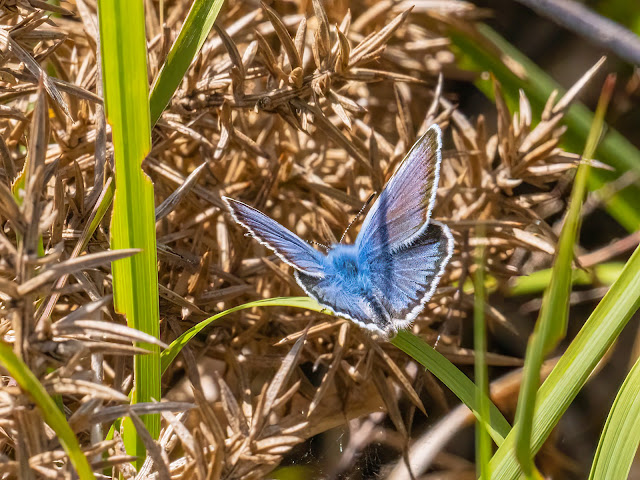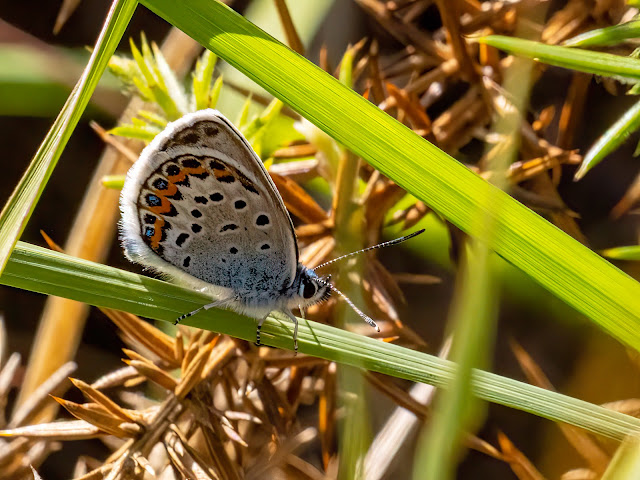On 2nd July 2023, I visited the following sites ….
Wareham Forest – Great Ovens NR
Purbeck Heaths NNR – Hartland Moor NNR
Today, my focus was on 3 heathland sites with the primary aim of seeing and photographing as many of the 6 species of UK reptile as possible, namely Adder, Grass Snake, Smooth Snake, Sand Lizard, Common Lizard and Slow Worm.
In addition, visiting such habitats provides similar opportunities in respect of heathland bird species plus a range of butterfly species and dragonfly and damselfly species.
My first visit of the day was to Great Ovens NR in Wareham Forest.
Great Ovens NR is adjacent to Morden Bog NNR which I visited last night. The reserve is owned by the Amphibian and Reptile Conservation Trust and covers 48 hectares of mainly dry heath. It is designated as a Site of Special Scientific Interest (SSSI), Special Area of Conservation (SAC), Special Protection Area (SPA) and Ramsar site.
Great Ovens NR was purchased by the Amphibian and Reptile Conservation Trust in 1996 with the use of a National Lottery grant. In 2020 a Forest Enterprise and Amphibian and Reptile Conservation Trust partnership extended the open reserve to the north by another 1.6 hectares.
At the northern end of the reserve is a large hill with a south facing aspect known as White Hill. This area, as with the rest of the site, is ideal for Sand Lizards due to its heather structure and large areas of open sand. Grading down from the bottom of White Hill is a large area of wet heath which eventually grades back up into a mix of dry heath and dwarf gorse making this whole area ideal for Smooth Snakes. Heading further south across the reserve, 2 ponds can be found. Both ponds are excellent for a large array of dragonfly species as well as newt species and Grass Snake.
Photo: Great Ovens NR
Photo: Great Ovens NR
Photo: Great Ovens NR
Photo: Great Ovens NR
Surprisingly and very disappointingly, I failed to see any of the 6 species of UK reptile during my visit despite much searching across the reserve.
However, I did have an enjoyable 4 mile and 3 hour walk in a beautiful landscape during which I had my first ever records of Grayling and Silver-studded Blue.
The highlights during my visit were as follows:
Birds (heard only records in italics): Dartford Warbler (3 plus 2 other calling birds heard), Tree Pipit (4), Stonechat (1 pair plus 4 other males), Yellowhammer (1 male, 1 female plus 3 another singing male heard), Linnet (7), Blackcap (1 singing male plus another singing male heard), Chiffchaff (1 singing male plus 3 other singing males heard), Coal Tit (1 heard calling), Greenfinch (1 male heard singing)
Butterflies: Grayling (2), Red Admiral (1), Silver-Studded Blue (1 female), Gatekeeper (at least 5)
Dragonflies: Black-tailed Skimmer (1 male), Four-spotted Chaser (1), Common Darter (2 females)
Photo: Grayling
Photo: Grayling
Photo: female Silver-studded Blue
Photo: female Silver-studded Blue
Photo: female Silver-studded Blue
Photo: Gatekeeper
Photo: Gatekeeper
Photo: male Black-tailed Skimmer
After my visit to Great Ovens NR, I drove a short distance to visit a site within the new Purbeck Heaths NNR: Hartland Moor.
Purbeck Heaths NNR combines 3 existing National Nature Reserves at Stoborough Heath, Hartland Moor and Studland and Godlingston Heath and links them with a significant amount of new land which includes nature reserves and conservation areas managed by a number of partner organisations: RSPB, Dorset WildlifeTrust, Amphibian and Reptile Conservation Trust, National Trust, Forestry England and Rempstone Estate Trust.
Purbeck Heaths NNR is a site of national and international importance for its extensive lowland heathland. The majority of this NNR is also designated as a a Site of Special Scientific Interest (SSSI), Special Area of Conservation (SAC), Special Protection Area (SPA) and Ramsar site.
Purbeck Heaths NNR is a mosaic of lowland wet and dry heath, valley mires, acid grassland and woodland, coastal sand dunes, lakes and saltmarsh. These habitats support a wide variety of insects, reptiles, birds and specialised plants that are rarely found elsewhere.
Photo: Purbeck Heaths NNR - Hartland Moor
Photo: Purbeck Heaths NNR - Hartland Moor
Photo: Purbeck Heaths NNR - Hartland Moor
Photo: Purbeck Heaths NNR - Hartland Moor
Photo: Purbeck Heaths NNR - Hartland Moor
Photo: Purbeck Heaths NNR - Hartland Moor
I again failed to see any of the 6 species of UK reptile during my despite much searching. However, I did have an enjoyable 2.5 mile walk during which I had my first ever record of Keeled Skimmer plus an abundance of Silver-spotted Blues.
The highlights during my visit were as follows:
Birds (heard only records in italics): Stonechat (1 male, 1 female plus 1 pair), Willow Warbler (1 singing male), Chiffchaff (2 singing males), Kestrel (1), Meadow Pipit (1 singing male plus 2 other singing males heard), Coal Tit (1 heard calling)
Butterflies: Silver-Studded Blue (at least 20), Large Skipper (1), Gatekeeper (at least 5), Meadow Brown (at least 5)
Moths: Silver Y (1)
Dragonflies: Keeled Skimmer (1 female), unidentified skimmer species (Black-tailed Skimmer and/or Keeled Skimmer (2)
Photo: male Silver-studded Blue
Photo: male Silver-studded Blue
Photo: female Silver-studded Blue
Photo: Silver-studded Blue
Photo: Silver-studded Blue
Photo: Silver-studded Blue
Photo: Silver-studded Blue
Photo: Silver-studded Blue
Photo: Silver-studded Blue
Photo: Silver-studded Blue
Photo: Silver-studded Blue
Photo: Silver-studded Blue
Photo: Large Skipper
Photo: Large Skipper
My final heathland site of the day was Creech Heath.
Creech Heath is another site managed by the Amphibian and Reptile Conservation Trust. It covers 80 hectares and is designated as a Site of Special Scientific Interest (SSSI), Special Area of Conservation (SAC), Special Protection Area (SPA) and Ramsar site.
Creech Heath consists of a mixture of habitats including dry and wet heath, acid bog, mixed deciduous and coniferous woodland and willow carr. Many large ponds are also dotted around the site. The site is home to all 6 species of UK reptile and 5 out of the 7 UK amphibian species including the Great Crested Newt. It is also home to a multitude of rare and endangered invertebrates including the extremely rare Southern Damselfly.
Photo: Creech Heath NR
Yet again, I failed to see any of the 6 species of UK reptile despite much searching. Neither did I have any confirmed sightings of Southern Damselfly although I did have some extremely distant views of some “blue” damselflies around the main pond which is a known location for this species. The reserve was relatively quiet but a fly-over Hobby was a welcome sighting.
The highlights during my visit were as follows:
Birds (heard only records in italics): Hobby (1), Dartford Warbler (1), Chiffchaff (2 singing males)
Butterflies: Silver-Studded Blue (at least 10)
Dragonflies: Emperor Dragonfly (1), Common Darter (1 female), unidentified “blue” damselfly (Azure Damselfly and/or Common Blue Damselfly and/or Southern Damselfly) (c.5)
After my visit to Creech Heath, I drove to my overnight stay at Woodyhyde campsite just outside Corfe Castle. This is a large campsite accommodating tents and campervans across 3 separate fields. It has large facilities block houses including showers and toilets plus it has a well-stocked shop providing fresh food, drinks and camping essentials. Whilst relatively busy, I still managed to find a quiet corner to pitch my tent.
Photo: Woodyhyde campsite
I had my evening meal at The New Inn in Church Knowle. I have visited this pub on 2 previous trips to Dorset and its excellent food and real ale were again an attraction.
After my evening meal, and after the success of yesterday evening, I had planned to visit another site for Nightjars, namely Godlingston Heath which is also part of the Purbeck Heaths NNR. I am not sure where I ended up but I don't think it was Godlingston Heath! However, wherever it was, I did manage to see a Red Fox, 1 Roe Deer and 2 Fallow Deer and hear a singing male Yellowhammer. I did not hear or see any Nightjars.
#DefendNature .... Please help save and enhance our laws that protect our environment and wildlife










































































No comments:
Post a Comment
If you feel like commenting on my blog, you can contact me by completing the comment form below. I will respond to all comments and enquiries and constructive criticism will always be welcomed.